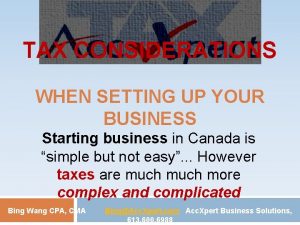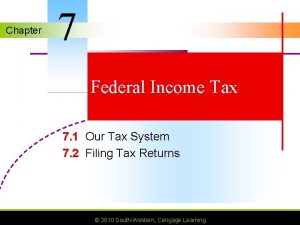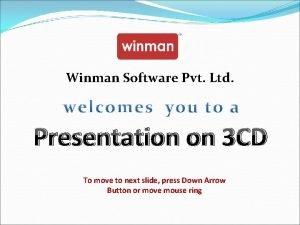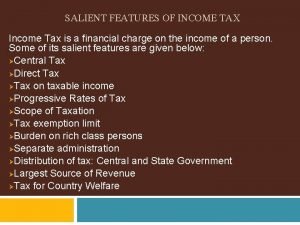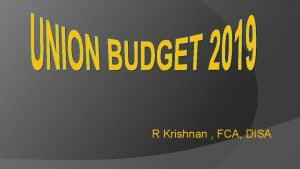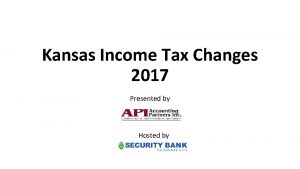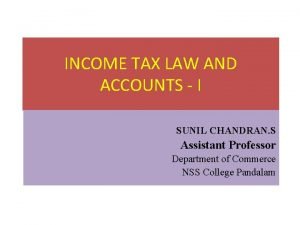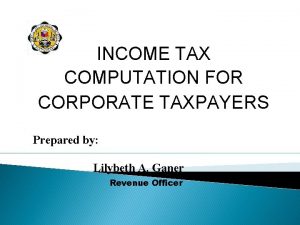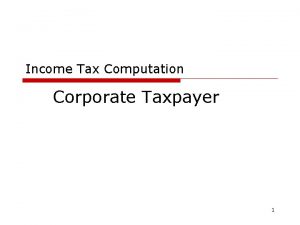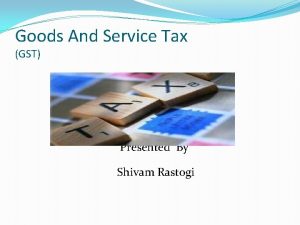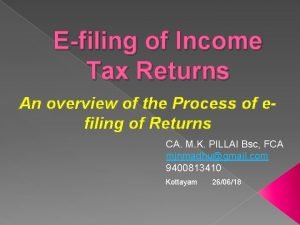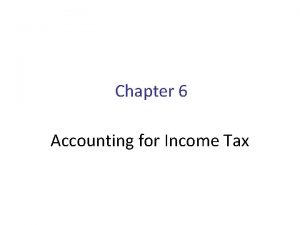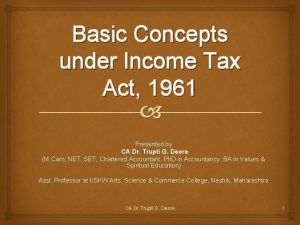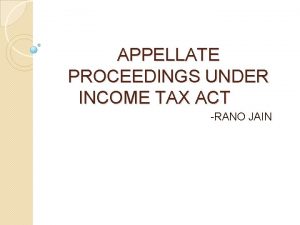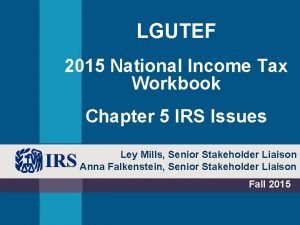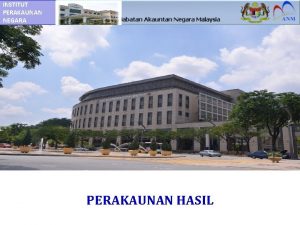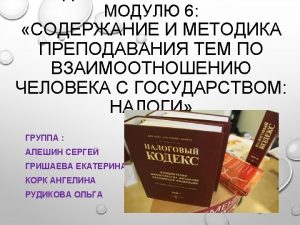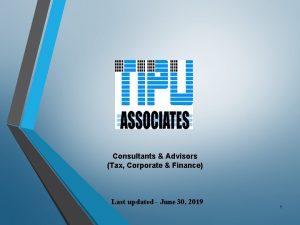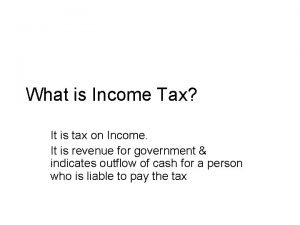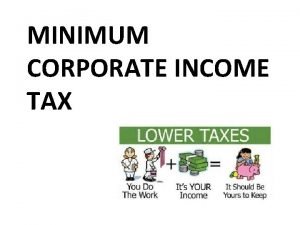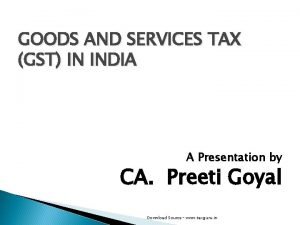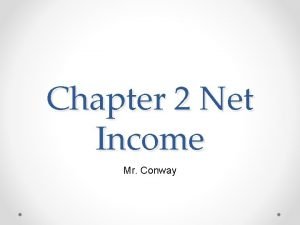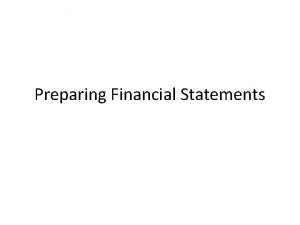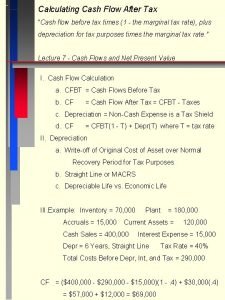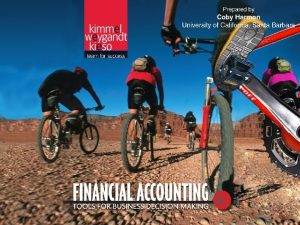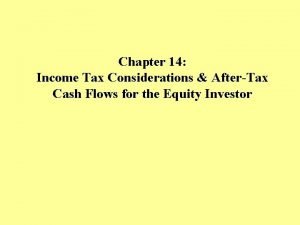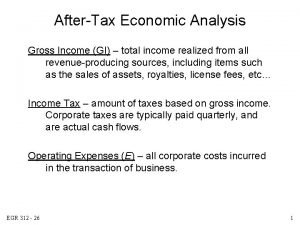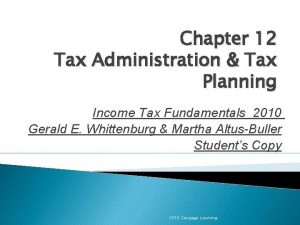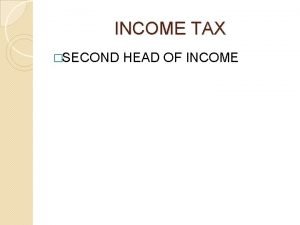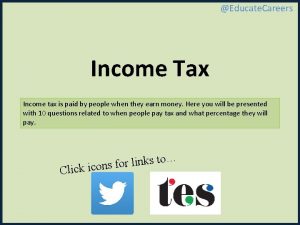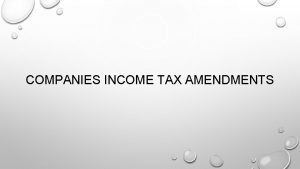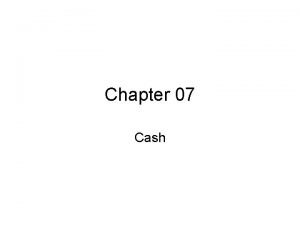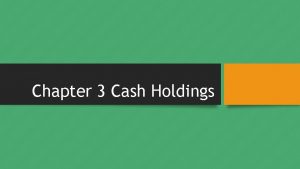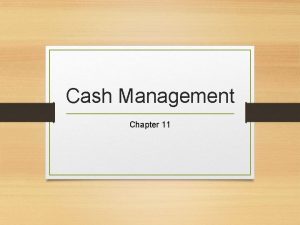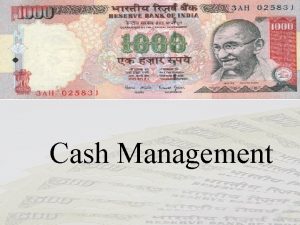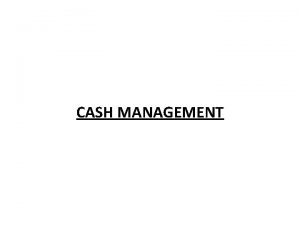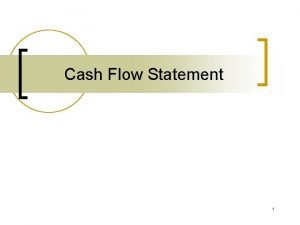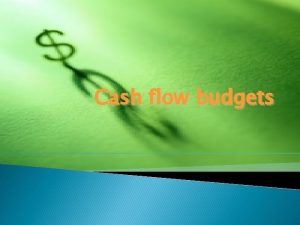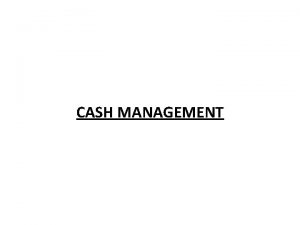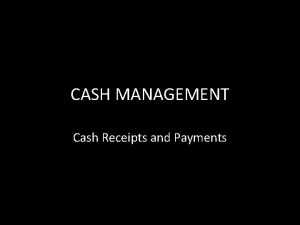Chapter 14 LECTURE INCOME TAX CONSIDERATIONS Aftertax Cash





































- Slides: 37

Chapter 14 LECTURE: INCOME TAX CONSIDERATIONS (“After-tax Cash Flows, Ch. 14)

Going from the “property before-tax cash flows” (PBTCF), to the “equity after-tax cash flows” (EATCF). . .

Property level: 1) Property level (PBTCF): – Net CF produced by property, before subtracting debt svc pmts (DS) and inc. taxes. – CFs to Govt, Debt investors (mortgagees), equity owners. – CFs due purely to underlying productive physical asset, not based on financing or income tax effects. – Relatively easy to observe empirically.

Property level (cont’d): 2) Equity ownership after-tax level (EATCF): – Net CF avail. to equity owner after DS & taxes. – Determines value of equity only (not value to lenders). – Sensitive to financing and income tax effects. – Usually difficult to observe empirically (differs across investors).

3 MAJOR DIFFERENCES (between PBTCF & EATCF levels): Depreciation: An expense that reduces income tax cash outflows, but not itself a cash outflow at the before-tax level. l Capital expenditures: Not an “expense”, hence not deducted from taxable income, even though they are a cash outflow. l Debt principal amortization: Like capex, a cash outflow, but not deductible from taxable income. l

From PBTCF to EATCF. . . Operating: PBTCF - IE DS <----+PP _______ EBTCF tax <---_______ EATCF to lender (NOI) - (DE) <---"Tax Shield" (DTS) - (IE) <---"Tax Shield" (ITS) offset by tax expense

From PBTCF to EATCF. . . Reversion: PBTCF - OLB ______ EBTCF - CGT = G(VT - SE - (VS + Acc. CI - Acc. DE)) ______ EATCF

Depreciation Expense (DE): l Straight-line – 39 years, commercial – 27. 5 years, residential (apts) l Land not depreciable: – (typic. 20% in Midwest – (often 50% in big E. & W. Coast cities)

Exhibit 14 -1 (p. 167), Example after-tax pro-forma. . . Exhibit 14 -1: Example After-Tax Income & Cash Flow Proformas. . . Property Purchase Price (Year 0): Depreciable Cost Basis: Ordinary Income Tax Rate: Capital Gains Tax Rate: TRADITIONAL FORMAT: $1, 000 $800, 00 0 40. 00% 28. 00% Before-tax IRR: After-tax IRR: Unlever ed: 10. 60% 7. 20% Levered 11. 86%: 10. 02% Oper. Yr. 10 Reversion Item: Rever. Yr. 10 Total Yr. 10 $1, 280, 085 $809, 091 Year: 1 2 NOI - Depr. Exp. - Int. Exp. =Net Income (BT) - Inc. Tax =Net Income (AT) $90, 000 $29, 091 $75, 000 ($14, 09 1) ($5, 636) ($8, 455) $92, 250 $29, 091 $74, 800 ($11, 64 1) ($4, 656) ($6, 985) $94, 556 $29, 091 $74, 600 ($9, 135) ($3, 654) ($5, 481) $96, 920 $29, 091 $74, 400 ($6, 571) ($2, 628) ($3, 942) $99, 343 $29, 091 $74, 200 ($3, 948) ($1, 579) ($2, 369) $101, 82 7 $29, 091 $74, 000 ($1, 264) ($506) ($759) $104, 37 2 $29, 091 $73, 800 $1, 481 $593 $889 $106, 98 2 $29, 091 $73, 600 $4, 291 $1, 716 $2, 574 $109, 65 6 $29, 091 $73, 400 $7, 165 $2, 866 $4, 299 $112, 39 8 $29, 091 $73, 200 $10, 107 $4, 043 $6, 064 Sale Price - Book Val =Book Gain - CGT =Gain (AT) $50, 000 $29, 091 $2, 000 ($28, 39 0) ($3, 654) ($32, 04 4) $0 $29, 091 $2, 000 $23, 148 $0 $29, 091 $2, 000 $24, 722 $0 $29, 091 $2, 000 $26, 332 $0 $29, 091 $2, 000 $27, 980 $0 $29, 091 $2, 000 $31, 390 $0 $29, 091 $2, 000 $33, 155 + Book Val -Loan. Bal =EATCF $809, 091 $730, 000 $418, 206 $50, 000 $29, 091 $2, 000 ($20, 33 5) $1, 716 ($18, 61 8) $451, 361 Operating: Accrual Items: Adjusting Accrual to Reflect Cash Flow: - Cap. Imprv. $0 $0 Expdtr. + Depr. Exp. $29, 091 -Debt. Amort $2, 000 =EATCF $18, 636 $20, 106 + Inc. Tax =EBTCF ($5, 636) $13, 000 ($4, 656) $15, 450 CASH FLOW COMPONENTS FORMAT: Year: Operating: 1 2 Accrual Items: NOI $90, 000 $92, 250 - Cap. Imprv. $0 $0 Expdtr. =PBTCF $90, 000 $92, 250 - Debt Svc $77, 000 $76, 800 =EBTCF $13, 000 $15, 450 -tax. NOI $36, 000 $36, 900 + DTS $11, 636 + ITS $30, 000 $29, 920 =EATCF $18, 636 $20, 106 3 3 $94, 556 $50, 000 $44, 556 $76, 600 ($32, 04 4) $37, 823 $11, 636 $29, 840 ($28, 39 0) 4 5 6 7 ($2, 628) $20, 520 ($1, 579) $23, 143 ($506) $25, 827 $593 $28, 572 4 $96, 920 $0 $96, 920 $76, 400 $20, 520 $38, 768 $11, 636 $29, 760 $23, 148 5 $99, 343 $0 $99, 343 $76, 200 $23, 143 $39, 737 $11, 636 $29, 680 $24, 722 6 $101, 82 7 $0 $101, 82 7 $76, 000 $25, 827 $40, 731 $11, 636 $29, 600 $26, 332 7 $104, 37 2 $0 $104, 37 2 $75, 800 $28, 572 $41, 749 $11, 636 $29, 520 $27, 980 8 8 $106, 98 2 $50, 000 $56, 982 $75, 600 ($18, 61 8) $42, 793 $11, 636 $29, 440 ($20, 33 5) 9 $470, 994 $131, 878 $339, 115 $481, 100 $345, 179 $4, 043 $37, 198 $587, 282 Oper. Yr. 10 Reversion Item Rever. Yr. 10 Total Yr. 10 $112, 39 8 $75, 200 $37, 198 $44, 959 $11, 636 $29, 280 $33, 155 Sale Price $1, 280, 085 $109, 65 6 $0 $109, 65 6 $75, 400 $34, 256 $43, 863 $11, 636 $29, 360 $31, 390 =PBTCF - Loan. Bal =EBTCF tax. Mkt. Gai n - Acc. DTS EATCF $131, 878 $550, 085 $2, 866 $34, 256 9 + CGT =EBTCF $1, 280, 085 $730, 000 $550, 085 $50, 424 $81, 455 $418, 206 $1, 39 2, 482 $587, 282 $95, 3 83 $69, 8 18 $29, 2 80 $451, 361

Traditional Format… l OPERATING NOI YEAR 1: = $90, 000, 1 yr. - Depr. Exp. - Int. Exp. =Net Income (BT) - Inc. Tax =Net Income (AT) st = $800, 000/27. 5 = $29, 091, ea. yr. = $750, 000*10% = $75, 000, 1 st yr. = 90000 - 29091 - 75000 = -$14, 091. = (. 4)(-14091) = - $5, 636, 1 st yr. = -14091 - (-5636) = - $8, 455, 1 st yr. Adjusting Accrual to Reflect Cash Flow: - Cap. Imprv. Expdtr. = - $0, 1 st yr. + Depr. Exp. -Debt. Amort =EATCF = + $29, 091, ea. yr. = - $2, 000, ea. yr (this loan). = (-8455 -0+29091 -2000) = $18, 636, 1 st yr. + Inc. Tax =EBTCF = +(-$5, 636) = -$5, 636, 1 st y r. = 18636 - 5636 = $13, 000, 1 st yr.

Traditional Format… l REVERSION Sale Price - Book Val =Book Gain YEAR 10: = VT - SE = NOI 11/. 09 - SE = 1. 025*$112, 398/0. 09 - 0 = $1, 280, 085 = - (VS + Acc. CI - Acc. DE) = - (1000000 + 100000 – 290910) = - $809, 091 = 1280085 – 809091 = $470, 994 - CGT = (. 28)(470994) = -$131, 878 =Gain (AT) = 470994 – 131878 = $339, 115 Adjusting Accrual to Reflect Cash Flow: + Book Val = + $809, 091 -Loan. Bal = - (750000 – 10*2000) = -$730, 000 =EATCF = 339115 + 809091 – 730000 = $418, 206 + CGT = + $131, 878 =EBTCF = 418206 + 131878 = $550, 085

Cash Flow Components Format… Operating: PBTCF = NOI – CI = $90, 000 - $0 = $90, 000, 1 st yr. IE = $750, 000 * 10% = $75, 000, 1 st yr. - DS <----+PP = + $2, 000 = $77, 000, 1 st yr. EBTCF = $90, 000 - $77, 000 = $13, 000 (NOI) = - (. 4)$90, 000 = $36, 000, 1 st yr. - tax <-- (DE) <---(“DTS”) = + (. 4)$29, 091 = $11, 636, ea. yr. - (IE) <---(“ITS”) = + (. 4)$75, 000 = $30, 000, 1 st yr. EATCF = $13, 000 - $36, 000 + $11, 636 + $30, 000 = $18, 636, 1 st yr.

Reversion (Yr. 10): PBTCF = 1. 025*$112, 398/0. 09 = $1, 280, 085. -OLB = $750, 000 – (10*$2, 000) = $730, 000. EBTCF = 1280085 – 730000 = $550, 085 -CGT Mkt Gain Component= - G(VT - SE – (VS+Acc. CI)) = - (0. 28)(1280085 -0 -(1000000+100000) = - (0. 28)(1280085 – 1100000) = $50, 424. - CGT DTS Recapture Comp. = - G(Acc. DE) = - (0. 28)($290, 910) = - $81, 455. EATCF = 550085 – (50424 + 81455) = 550085 - 131878 = $418, 206.

10 -yr Going-in IRR: Before-tax After-tax AT/BT Effective Tax Rate with ord=40%, CGT=28% Property (Unlvd) Equity (Levd) 10. 60% 11. 86% 7. 20% 10. 02% 720/1060 = 68% 1002/1186 = 84% 100% – 68% = 32% 100% - 84% = 16%

Apprec. Rate = 2. 50% Bldg. Val/Prop. Val= Yield = Income Tax Rate = 9. 00% Depreciable Life= 40. 00% CGTax Rate = (1) Year 0 1 2 3 4 5 6 7 8 9 10 Prop. Val $1, 000, 0 00 $1, 025, 0 00 $1, 050, 6 25 $1, 076, 8 91 $1, 103, 8 13 $1, 131, 4 08 $1, 159, 6 93 $1, 188, 6 86 $1, 218, 4 03 $1, 248, 8 63 $1, 280, 0 85 IRR of above CF Stream = (2) (3) NOI PBTCF ($1, 000, 00 0) $90, 000 $92, 250 $94, 556 $50, 000 $44, 556 $96, 920 $99, 343 $101, 82 7 $104, 37 2 $106, 98 2 $109, 65 6 $112, 39 8 $0 $99, 343 $0 $101, 827 $0 $104, 372 $50, 000 $56, 982 $0 $109, 656 $1, 392, 48 2 $0 10. 60% (5) tax w/out CI 27. 5 28. 00% (4) 80. 00% years Int= Amort/y r (6) (7) (4)(5)+(6) shields $750, 00 0 10. 00% $2, 000 (8) (9) Loan (10) $11, 636 $65, 636 $11, 636 $66, 986 $11, 636 $18, 370 $11, 636 $69, 788 $11, 636 $71, 242 $11, 636 $72, 732 $11, 636 $74, 260 $11, 636 $25, 825 $11, 636 ($69, 81 8) $77, 430 $1, 227, 2 81 Loan. Bal $750, 00 0 $748, 00 0 $746, 00 0 $744, 00 0 $742, 00 0 $740, 00 0 $738, 00 0 $736, 00 0 $734, 00 0 $732, 00 0 $730, 00 0 $36, 00 0 $36, 90 0 $37, 82 3 $38, 76 8 $39, 73 7 $40, 73 1 $41, 74 9 $42, 79 3 $43, 86 3 $95, 38 3 7. 20% (11) PATCF ($1, 000) DTS Loan= DS ($750, 0 00) $77, 000 (12) (7)(9)+(10) (4)-(9) ITS EBTCF ($250, 00 0) EATCF ($250, 000) $30, 000 $13, 000 $18, 636 $76, 800 $29, 920 $20, 106 $76, 600 $29, 840 $15, 450 ($32, 044 ) ($28, 390) $76, 400 $29, 760 $20, 520 $23, 148 $76, 200 $29, 680 $23, 143 $24, 722 $76, 000 $29, 600 $25, 827 $26, 332 $75, 800 $29, 520 $27, 980 $75, 600 $29, 440 $28, 572 ($18, 618 ) ($20, 335) $75, 400 $805, 20 0 $29, 360 $34, 256 $31, 390 $29, 280 $587, 282 $451, 361 11. 86% 10. 02%

Does the lower effective tax rate on levered equity imply a “free lunch” (i. e. , NPV>0)? NO. . . “Adjusted Present Value” (APV)… Like NPV, only accounts for financing: APV(Equity) = NPV(Property) + NPV(Financing). Unless NPV(Financing) > 0, no “free lunch” from leverage. NPV(Financing)= (Loan Amt) – (Mkt Val of Debt) 0, otherwise bank goofed!… For lender: NPV = (Mkt Vale of Debt) – (Loan Amt).

Sometimes, NPV(Financing) > 0 for borrower… “Subsidized Loan”: Below-market interest rate (e. g. , “Seller Financing”) For borrower: NPV(Financing) = (Loan Amt) – PV(Loan CFs, @ MKT Int Rate) For “Market Value”, Discount BTCFs @ BT OCC. For “Investment Value”, Discount ATCFs @ AT OCC.

Numerical example… You believe property value is: V = $20, 000. Seller wants: P = $20, 500, 000. Seller offers $10, 000 interest-only loan @ 5% interest rate. Market interest rate on such loans is currently 8%. What is NPV(Financing) and APV of this deal? … (Assume annual pmts at end-of-periods. )

On a “Market Value” (MV) basis: Thus: APV = NPV(Property) + NPV(Financing) = ($20 M - $20. 5 M) + $1. 2 M = (-0. 5 M) + 1. 2 M = + $700, 000.

On an “Investment Value” (IV) basis if borrower faces 40% income tax rate: Thus: APV = NPV(Property) + NPV(Financing) = ($20 M - $20. 5 M) + $0. 8 M = (-0. 5 M) + 0. 8 M = + $300, 000.

How much more than $20, 000 should buyer be willing to pay (if they must)? . . . Answer: V + NPV(Financing), based on IV. = $20 M + 0. 8 M = $20, 800, 000.

The "Bigger Picture": Other reasons to use or avoid debt financing: (AKA: Considerations in real estate “optimal capital structure”…) A. Reasons to borrow. . .

1. Leverage human capital: - “Mom-&-Pop” level: ownership guarantees job as prop. mgr. - Need debt capital to reap econ. of scale in prop. mgt, due to capital supply constraints or control issues associated with raising external equity capital at Mom&Pop level. - At “institutional” or REIT level this argument makes less sense, because equity capital can be accessed and used as well as debt capital to obtain scale economies or apply management and franchising expertise over a wider base.

2. Diversify or Target your risky investments while keeping control: 1. Direct investment in property is "lumpy" (must buy "whole assets"). - Small investors need to "stretch" their capital in order to diversify. - Problems with external equity capital (as above). - So debt capital helps small investors diversify their risky holdings. - Diversification enables greater expected returns to be achieved for any given level of risk exposure.

1. CAVEAT: Do not borrow in order to lend: 1. diversification occurs through long positions in risky assets.

1. 3. Leverage as a "disciplinary tool" to "incentivize" good mgt: 1. Real estate physical assets are "easy to manage, not much risk or excitement or growth potential in bricks & mortar" (e. g. , compared to high-tech industries, world trade, etc). - With not much downside and not much upside, managers may tend to get "lazy", letting value-enhancing possibilities pass them by unnoticed. - With sufficient leverage, real estate becomes a high-risk, high-growth investment, making it sufficiently "exciting" to attract good mgrs, giving mgrs sufficient incentive to max value. - This argument not based on a capital constraint or capital mkt failure for small investors, and so this argument for debt financing applies not only to small individual investors but to large insts & REITs.

1. B. Reasons not to borrow (or to borrow less). . . 1. Leverage reduces the equity investor's "liquidity": 1. "Liquidity" = Ability to quickly obtain "full value" as cash. - Underlying (physical) R. E. assets are illiquid. - By not borrowing to the hilt, you can obtain cash by mortgaging the prop. (i. e. , if you don't borrow now, you can borrow later), thereby reducing the illiquidity problem of real estate investment. - Liq. valuable because it gives the investor flexibility, provides options: Pounce on pos. -NPV opportunities; Avoid being foreced into neg. -NPV deals. - Liq. Allows you to use the R. E. cycle to your advantage instead of being a victim of it. (More important in R. E. than stocks due to lack of info. effic. in R. E. mkts.

1. 2. The "Cost of Financial Distress" (COFD): 1. (See Brealey-Myers Ch. 18. ) - Bankruptcy or foreclosure has large "deadweight costs". - Also “agency costs”: High L / V ratio Conflict of interest betw equity owner vs debtholder. Can cause prop. owner to act suboptimally (e. g. : avoid CI, pad expenses, high-stakes “repositioning” of rent roll, exercise mortgagor’s “put”): "moral hazard". - Mere probability of these costs (deadweight, agency) reduces value of prop. if L / V too high (even though L / V still < 1). - Thus, optimal L / V always < 1.

1. However, … 1. - The "easy management", low risk nature of R. E. , & transparency (relatively easy for outsider to detect poor mgt, in part via ability to observe prop. val. in asset mkt) COFD does not “kick in” for R. E. until higher L / V ratio than for other types of investments (e. g. , typical stock)

1. C. Considerations that are important but generally neutral. . 1. Inflation: - "The more you borrow, the more money you make just from inflation!" - Do borrowers know more about inflation than lenders? . - Inflation is only the borrower’s friend ex post. - Ex ante (which is when it matters for leverage decision) the inflation argument is a fallacy. No positive NPV to borrower in loan transaction due to inflation. However, fixed-rate debt leverage makes equity position more of an "inflation hedge".

1. 2. Obtain "Interest Tax Shields" (ITS): 1. “Get those valuable ITS: The more you borrow, the more ITS you get!”

Obtain "Interest Tax Shields" (ITS): 1. - Also generally a fallacy for real estate: Debt capital comes from lenders who must pay taxes on their interest income, at least the marginal lenders, the ones who define the prices and yields in the debt market. Therefore, lenders require interest rates high enough to cover their income taxes and still leave a sufficient after-tax yield. Borrowers are not avoiding taxes, only paying them indirectly via the interest they pay to lenders who then pay the taxes to the Government. It is a "pass-through" of taxes. No net gain to the private sector, and so no positive NPV in the borrowing deal as a result

Obtain "Interest Tax Shields" (ITS): (Note: tax-exempt bond investors are "intramarginal", earning pos. NPV due to tax exemption. Tax-exempt issuers of mortgages charge rates equivalent to bond mkt rates. Otherwise they would prefer to invest in bonds instead of mortgages. )

Obtain "Interest Tax Shields" (ITS): - However, different types of investors face different tax rules: corporate real estate investments by highly profitable firms subject to corporate income tax (double-taxation) will have a modest value from ITS on real estate investments. If borrower faces higher income tax rate than marginal lender in debt mkt, then there will be some positive NPV in debt due to ITS, as long as L / V not too high.

Obtain "Interest Tax Shields" (ITS): - The Brealey-Myers (Ch. 18 -19) framework is useful to quantify the value of ITS for various types of real estate investment situations. . .

Exhibit 1: Relation between Investment Value (IV) and Market Value (MV) in a well-functioning asset market P S INTRA-MARGL. BUYER IV ASSET PRICE=MV INTRA-MARGL. SELLER IV D Q P = Asset prices (vertical axis). Q = Volume of investment transaction per unit of time. Q 0 = Volume of transactions by investors with more favorable circumstances, hence would enter market at less favorable prices (i. e. , “intra-marginal” market participants). Q* = Total volume of asset transactions, including marginal investment (investors on margin are indifferent between investing and not investing in assets: NPV=0).

Exhibit 2: Relation between Investment Value (IV) and Market Value (MV) in the debt market. . . L S IVA=$101. 92=$106/1. 04 MV=$100=$104/1. 04 IVC=$99. 04=$103/1. 04 D Q 0 Q D* QD
 Tax considerations for setting up a new business
Tax considerations for setting up a new business Chapter 7 federal income tax
Chapter 7 federal income tax Value added method gdp
Value added method gdp What is a tax base
What is a tax base Operating activities
Operating activities Deferred tax asset journal entry
Deferred tax asset journal entry How to file income tax return in winman software
How to file income tax return in winman software Movable assets
Movable assets What are the salient features of income tax
What are the salient features of income tax 195 of income tax act
195 of income tax act Kansas income tax rates
Kansas income tax rates Perquisites in income tax
Perquisites in income tax How to compute for mcit
How to compute for mcit Income tax computation format
Income tax computation format James wilson income tax
James wilson income tax How to compute federal income tax
How to compute federal income tax Individual tax computation format
Individual tax computation format Easy office download
Easy office download Income tax expense
Income tax expense Income tax meaning
Income tax meaning Government taxes definition
Government taxes definition Form 35 income tax
Form 35 income tax Income tax expense
Income tax expense Lgutef
Lgutef Titik pengiktirafan hasil
Titik pengiktirafan hasil Citizen and resident
Citizen and resident Income tax in russia
Income tax in russia Nccpl
Nccpl Income tax slab
Income tax slab What is mcit
What is mcit 01:640:244 lecture notes - lecture 15: plat, idah, farad
01:640:244 lecture notes - lecture 15: plat, idah, farad Conclusion of gst
Conclusion of gst Roland purcell a technical writer
Roland purcell a technical writer Basal state blood collection
Basal state blood collection Petty cash in income statement
Petty cash in income statement Calculating cashflow
Calculating cashflow Common stock in cash flow statement
Common stock in cash flow statement Juarez company acquired $1 200
Juarez company acquired $1 200
